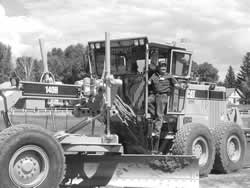|
Revised
Hours-of-Service Regulations
| |
 |
| |
Changes to Hours-of-Service regulations aim to increase
driver alertness. |
| |
|
Hours-of-service regulations were
first prescribed for truck drivers in 1939. Over the years
there have been many changes in regards to road construction,
truck design, and mobility aspects. Many of these factors,
in conjunction with an increase of commercial motor vehicle
crashes, have led to a revision of the old Hours-of-Service
(HOS) regulations.
In response to a Congressional directive
in 1995, the Federal Motor Carrier Safety Administration
(FMCSA) began rulemaking to increase driver alertness and
reduce fatigue-related incidents. The intent was to establish
new regulations that provide commercial truck drivers a
work and rest schedule that is more in line with a person's
circadian rhythm, thus reducing driver fatigue. For example,
under the new rules, long haul drivers are allowed to drive
11 hours after 10 consecutive hours off duty.
In April 2003,
the FMCSA posted the new HOS revisions with a compliance
date of Jan. 4, 2004. However, the new regulations only
apply to property carriers and drivers. Passenger carriers
and drivers will continue to operate under the existing rules
while fatigue issues specific to the passenger carrier
industry are assessed.
The new HOS rules for property-carrying
CMV drivers simply states:
-
Drivers may drive up to 11 hours
instead of 10 hours, but are limited to 14 hours in a
duty period.
-
The 14-hour duty period may not be extended to off-duty
time for meal and fuel stops, etc. Only the use of a
sleeper berth can extend the 14-hour on-duty period.
-
Each duty period
must begin with at least 10 hours off-duty, rather than
eight.
-
The 60 hours on-duty in seven consecutive days, or
70 hours on-duty in eight consecutive days, remains the
same, but drivers can “restart” the seven-
or eight-day period by taking at least 34 consecutive
hours off-duty.
Exemptions
There is a 16-hour exception provided for property-carrying
drivers. Drivers may extend the 14-hour on-duty period
by two additional hours IF THEY:
-
Are released from duty
at the normal work reporting location for the previous
five duty tours, AND
-
Return to the normal work reporting
location and are released from duty within 16 hours,
AND
-
Have not used this exception in the previous 6 days,
except following a 34-hour restart of a seven- or eight-day
period.
The
FMCSA also provides Sleeper Berth, Industry and Agricultural
exemptions. For an outline of these exemptions, FMCSA has
developed an HOS fact sheet at http://www.fmcsa.dot.gov/Home_Files/hos/faxsheet.pdf. Adverse Weather Exemption
The new HOS rule continues to permit a driver to exceed the
10 or 11-hour driving limit by no more than two hours under
adverse weather conditions; however, this adverse weather
exception does not permit a driver to exceed the 14- or
15-hour limit or the 60/70 hour limit. An absolute pre-requisite
for any use of the adverse weather exception must be that
the trip involved is one that could normally and reasonably
have been completed without a violation and that the unforeseen
event occurred after the driver began the trip. Drivers
who are dispatched after the motor carrier has been notified
or should have known of adverse driving conditions are
not eligible for the two hours additional driving time
provided for under regulatory guidance Part 395.1(b), adverse
driving conditions. Also, the term “in any emergency” shall
not be construed as encompassing such situations as a driver's
desire to get home, shippers’ demands, market declines,
shortage of drivers, or mechanical failures.
Penalties
Drivers or carriers who violate the new HOS rules face serious
penalties. The following is a list of possible penalties;
however, FMCSA will only take enforcement measures for
egregious violations during the first 60 days the rule
is in effect. Compliance with the new rules was required
starting
Jan. 4, 2004!
-
Drivers may be placed out-of-service (shut down)
at roadside until the driver has accumulated enough off-duty
time to get back in compliance;
-
State and local enforcement
officials may assess fines;
-
FMCSA may levy civil penalties
on driver or carrier, ranging from $550 to $11,000 per
violation, depending on severity;
-
The carrier's safety rating can be
downgraded for a pattern of violations; and
-
Federal criminal
penalties can be brought against carriers who knowingly
and willfully allow or require HOS violations.
Additional
issues, such as electronic on-board recorders, waiting-time,
24- and 34-hour restarts, 100 air mile exemption, sleeper
berth, oil field operations and more, are addressed in
a Frequently Asked Questions document prepared by FMCSA available
at: http://www.fmcsa.dot.gov/Home_Files/hos/hos_faqs.pdf.
For
more info on: USDOT and Status of DOT Numbers, Operating
Authority Info, Safety Ratings, Insurance Filing Info,
etc., call the FMCSA Information Line at 1-800-832-5660.
The Hours-of-Service Help Line is
1-800-598-5664. |

